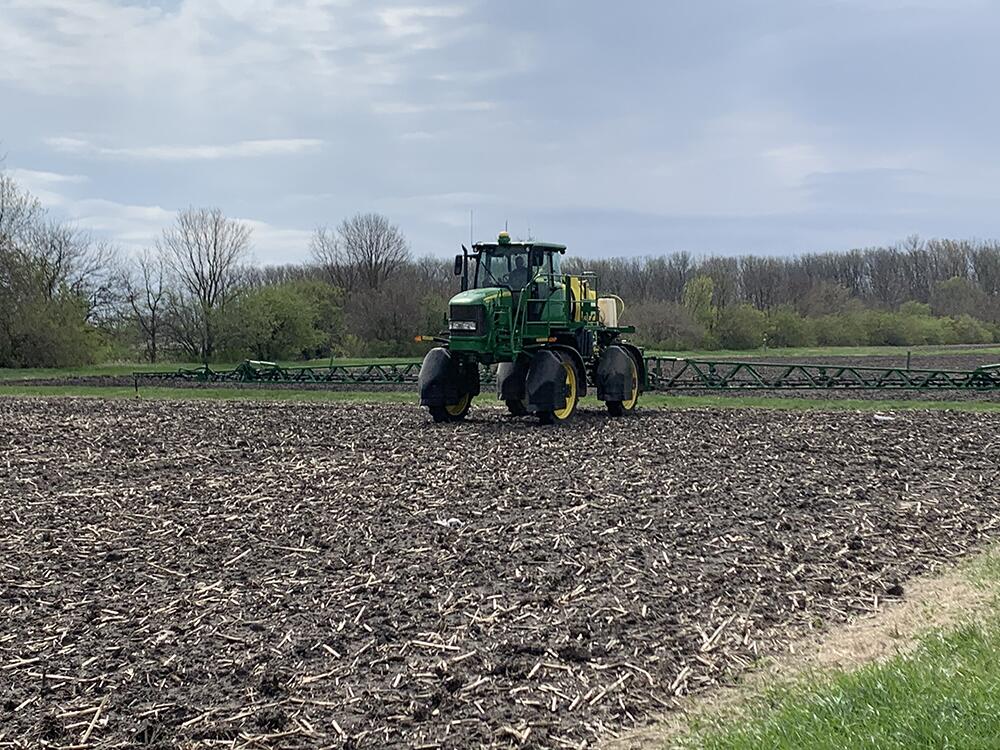Crop Sciences research poised perfectly for these times

URBANA, Ill. – Crop scientists are the original social distancers, muses Allen Parrish, director of the Crop Sciences Research and Education Center at the University of Illinois.
“Planting season is always a demanding time of the year,” he says. “We obviously have restricted working conditions with the social distancing because of coronavirus, but for the most part that’s the nature of our work. One person on the ground getting things ready; one person in a sprayer or planter. Those are single-operator activities, so the current conditions don’t critically hinder us.
“It is a seasonal song-and-dance the farm managers have honed over the years. That experience will be invaluable for this year’s planting season.”
The farm equipment is large enough that people can work together and still keep a safe distance from each other. They work outside, using face masks and gloves, so farm operations can continue almost as usual as the world works its way through the pandemic.
Still, the crop scientists face COVID-19-related challenges, such as delays in delivery of seed and other supplies as ag companies operate with limited staff and a reduced supply chain.
“Those things are ripple effects to our operations which are outside our scope,” Parrish says.
And he is confident the ag community’s fighting spirit will prevail in the current situation.
“We understand the value of what we do and how it benefits our nation,” he says. “We have to continue to keep moving along; otherwise people may come into hard times because we are not doing our job.”
The Department of Crop Sciences in the College of Agricultural, Consumer and Environmental Sciences (ACES) at Illinois operates several research centers and farms, including about 16 acres on the south side of Urbana-Champaign, as well as the Morrow plots in the middle of campus, and field locations in Monmouth and Baylis.
Right now research center staff are taking advantage of the nice weather to plant oat varieties for plant-breeding trials. Soil conditions have been excellent for getting ground ready for researchers as well.
As you look across the landscape you see farmers hard at work getting their crops planted. Research takes on a different size and scope that is often more time-consuming and tedious, Parrish notes.
“We plant four-row plots that are 10 feet wide by 23 feet long,” he says. “Then we fill packets with seeds, and there are quite a number of varieties in a single area. An operator on the planter must pour out each of the small packets individually.”
The Variety Testing program treats crops with similar fertilizer and herbicide protocols, so the only factor that changes is the genetics.
“That allows the team to compare the performance of different varieties. This is very important information that farmers and industry use for the 2021 season,” Parrish explains.
Field staff also recently harvested miscanthus, which manager Tim Mies at the U of I Energy Farm uses in a boiler system to heat a greenhouse. Grown and used on the farm, the crop creates a zero-carbon loop system and helps the Crop Sciences department cut down expenses.
It was not difficult to follow social-distancing guidelines for that work.
“Each person is sitting in the cab of a tractor; there’s a self-propelled forage chopper that chops everything up and blows it into the wagons. Then you drive it by the person running the bagger, who fills a big silage bag with the contents, and then you empty it out and go on your way,” Parrish says.
“You never have to get out or come into contact with anyone. It’s very isolated work, and it needed to get done so we could continue our operations.”
While field work lends itself to social distancing, other activities such as staff meetings shifted to telecommunications.
However, the restrictions prove more challenging for large research groups with graduate students used to close collaboration. Technology can facilitate planning and communication, but some on-site labor still has to get done. Rotating shifts and spreading tasks out to different locations accommodate social-distancing guidelines but can make the work more of a challenge.
“It’s not always easy when you have to make a phone call rather than ask the person right next to you, or you have to run to pick up something you forgot in the lab or office,” Parrish notes.
Crop scientists, like farmers, are no strangers to challenges outside their control. Last year, heavy spring rains made planting difficult and delayed, so this year they are eager to get in the field.
Parrish says ag researchers and farmers are committed to their mission of sustaining the world.
“Even though the ag community is small, we produce a lot that others turn into other products and services that help families,” Parrish says.
“That motivates everyone on our farm staff and our faculty. Everyone sees what they’re doing as going beyond the immediate purposes and pushing the knowledge needle so we can be better stewards of our land and resources.”